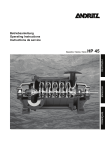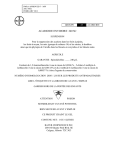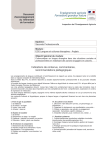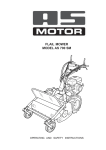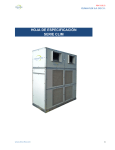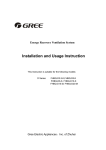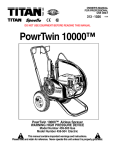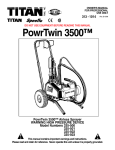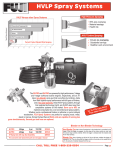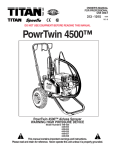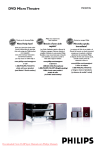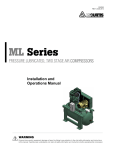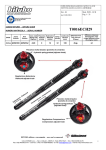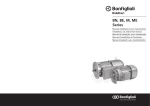Download Operator`s Manual, Parts List & Service Manual
Transcript
475 Outperforms Operator’s Manual, Parts List & Service Manual STOP! If you are missing parts, instructions or have questions, DO NOT take this unit back to the store. Call 1-800-888-4897 and MasterLine will send the missing parts/information to you promptly MAINTENANCE TIP: Cap gasket is prelubricated for improved sealing. Occasional lubrication is recommended, use petroleum jelly or non-water soluble grease. SAFETY PRECAUTIONS 1. 2. Before using sprayer with chemicals, fill sprayer with fresh water to assure that you have it properly assembled; pressurize and practice spraying. Also, check for any leaks at this time. When thoroughly familiar with the sprayer operation, follow normal operating procedures. 3. Avoid contact with chemicals. 4. Always wear rubber gloves, safety goggles, appropriate protective clothing. 5. Work in a well ventilated area. Ensure all pressure in the sprayer is relieved by locking the shutoff valve in the open position. 6. Individuals should be trained in the proper use of this sprayer, chemical handling procedures, and first aid/emergency care. Where training is not available, individuals should study and follow the procedures detailed in this menual. WARNING: Chemicals can be harmful to individuals and the environment if improperly used. In addition, some chemicals are caustic, corrosive or poisonous and should be avoided. Read warnings and chemical manufacturers’ instructions. MASTERLINE high density polyethylene sprayers are fitted with Viton® seals which are resistant to a wide variety of agricultural and household chemicals; however, care should be exercised to ensure that sprayer components are clean, functioning properly, and in a good state of repair before and during use. If in doubt about a particular chemical, check with the manufacturer. If you suspect or observe indications that the material may be unsafe in a MASTERLINE sprayer....STOP. Do Not Use or Apply Chemical. Always wear rubber gloves, safety goggles, and appropriate protective clothing. • • • • • • • • • Read and follow operating instructions. Do not fill with, use or spray flammable materials. Do not modify sprayer. Never spray in the direction of humans, animals or property which might be injured or damaged by spray formula. Do not use disinfectants, solvents or impregnating agents unless first tested to ensure they are not harmful to the environment or sprayer. Do not use liquids with a temperature above 110°F (43°C). Rinse and clean sprayer thoroughly after using. Chemicals can be dangerous and cause serious injury to persons, animals, plants and environment. Wear appropriate protective clothing to prevent contact with chemical agents. Disposal of contaminated rinse should be in accordance with applicable ordinances. Observe the precautionary instructions of the chemical manufacturer. ASSEMBLY INSTRUCTIONS: SPRAY TIP ASSEMBLY Spray tips should be assembled as shown. O-rings are used in place of gaskets in some sprayers. 1. 2. 3. 4. 5. • • • • • All servicing personnel should be trained and familiarized with chemical handling procedures, first aid/emergency care, and chemical liquid disposal regulations. DO NOT USE ANY ACID (INCLUDING CITRUS) OR CAUSTIC CHEMICALS INCLUDING BLEACH. Remember that a sprayer with liquid is a significant amount of weight (8 lbs. per gallon). Use caution when bending, leaning or walking. Do not bend at the waist when wearing the backpack. Bend only at the knees and support yourself as required to ensure personal safety. Keep in mind that the sprayer tank is vented at the cap and was intended to be operated upright. Do not climb or mount any equipment from which you might fall. Flat Spray Nozzle Filter Jet Stream Nozzle Swirl Plate Brass Adjustable Nozzle 5 3 4 1 2 2 2 See Page 11 for Handle Installation. MasterLine Manual 2007.indd 1 3/20/2007 4:27:21 PM REGULATING THE PRESSURE The MASTERLINE backpack sprayer is equipped with a built-in regulator to control output pressure. This regulator is operator adjustable. Make adjustments prior to filling tank. To adjust the regulator, remove the tank cap and the filter basket. Look inside the spray tank; you will see the top of the regulator. There are 4 fingers sticking out of the cap. They are numbered 1,2,3,4. 1=15 psi, 2=30 psi, 3=45 psi, 4=60 psi. The higher the pressure, the more chemical applied from the sprayer in a given amount of time, but the droplets will be smaller and tend to drift. The lower the pressure, the less chemical applied in a given amount of time, but the droplets will be larger with less drift. If the spray pressure must be changed, excess pressure in the pressure cylinder must be released back into the tank through the spray tube. FILLING of liquid in formula tank will appear to decrease as the pressure cylinder is filled. Liquid will flow through the top of the pressure regulator when the cylinder is completely full. Add the remaining formula mix to the tank. Remember that it’s not necessary to fill the sprayer tank each time. Mix only the amount needed to get the job done. Mix the spray formula and the proper volume of water in a separate container. Pour the mix through the filter basket in the tank opening. This keeps debris from entering sprayer. Note: To fill the sprayer to its full 4 gallon capacity, set the pressure regulator to the 3 or 4 setting. (Pressure regulator is mounted on top of the pressure cylinder inside formula tank. See Above: Regulating the Pressure.) Add 2 or 3 gallons of spray formula mix. Pump the sprayer handle to prime the pump and fill the pressure cylinder. The volume Always read and follow manufacturer’s instructions printed on the spray product label. This can save money and help prevent crop and environmental damage. SPRAYING Prime the pump with rapid pump strokes. When you feel very firm resistance, the pressure chamber is filling with liquid. With repeated strokes, the air in the pressure chamber is slowly compressed. By pressing the hand lever, the valve opens, and liquid is forced through the nozzle. The shutoff valve has a retaining clip which keeps the valve in the “OPEN” position for continuous operation. Pump using the end of the pump handle as it is less fatiguing. The volume of liquid delivered varies with the working pressure which should be as high as needed to ensure an adequate spray pattern for each individual application. NOTE: Should the pressure drop very quickly, drain the tank completely and pump without liquid. By this procedure, the air chamber is refilled with the required volume of air. It is advisable to pump the tank completely empty from time to time. CLEANING • • • After spraying, clean the tank thoroughly. If some spray liquid is left inside, drain tank completely. Follow the recommendations of the chemical manufacturer for disposal of waste water and storage of chemicals. Pumping causes air to be taken in and the remaining liquid to be discharged. Pump until liquid and air are coming out through the nozzle. • • • • • Refill tank with a few quarts of clean water and pump the water out as explained above (if necessary, repeat this procedure several times). If the shut-off valve is removed, the pump can be flushed quickly. Improper spray distribution is the result of a clogged nozzle, which is easily removed and cleaned. Soap and water may also be used to clean tank. Do not use aggressive cleaning agents or abrasives. Activated charcoal in liquid or other form may be used to absorb chemicals in tanks or spills. NOTE: When cleaning the sprayer after working with hormone weedkillers, follow the instructions of the herbicide producers. Neutralize with activated charcoal. (Example: add 0.35 oz. 1 g. of activated charcoal to 1.7 imp. pint 1 liter of water and leave this in the tank and the lines for approximately 24 hours. This is very important if other chemicals should be sprayed as the residues of the herbicide may damage susceptible plants. Cleaning after application of products containing carbolineum, if they are not water soluble, should be done with a 5% soda lye having a temperature of 104°F (40°C). Rinse with plenty of clean water. 2 MasterLine Manual 2007.indd 2 3/20/2007 4:27:22 PM CALIBRATION OF MASTERLINE BACKPACK SPRAYERS The output of the sprayer should be checked by collecting and measuring the spray liquid emitted during one minute. Maintain steady pumping on the pump handle while measuring. Having determined the output from the nozzle in gallons/minute, the rate per unit area treated can be calculated knowing the swath width and walking speed. WILL THE PLASTIC MATERIAL LAST? Only high-density polyethylene is used. The material is chosen for high molecular weight, high impact strength, and excellent resistance to chemicals and stress. Ultraviolet inhibitors are used in the material to reduce deterioration caused by sunlight. HOW HEAVY IS THE UNIT? When empty, Model 475 weighs only 9.5 lbs. IS THE SPRAYER COMFORTABLE TO CARRY? MASTERLINE sprayers are probably the most comfortable spraying equipment on the market. The tank rests comfortably against the operator’s back and the straps are made from a nylon web and are padded where they rest on the shoulders. The pump lever is positioned at the most convenient height and can be varied with adjustment of the straps. CAN I USE WEEDKILLER AND INSECTICIDE IN THE SAME SPRAYER? In theory you can, if the sprayer is thoroughly cleaned out with an ammonia: water solution of 1:25. In practice, the use of both types of chemicals in the same unit is not recommended as the risk to the plants can be high. Use caution when handling any type of chemicals and when cleaning your sprayer. Gal/Acre = (Gal./min of nozzle) x 43560 Sq. ft./acre (Sq. ft./min.) Note: Gal/min for standard nozzles WHAT SPRAY NOZZLE SHOULD I USE? A brass adjustable spray nozzle is supplied for varying the spraying pattern from a fine mist to a jet stream. A flat spray nozzle is supplied for spraying paths, garden beds, and general area spraying. A cone nozzle is also supplied for spot spraying and for treatment of bushes and small trees. For spot spraying, simply remove swirl plate from behind cone. Save the swirl plate for future use. Standard is a reflux filter with a built-in check valve which opens at 5 psi and closes at 4 psi. This virtually eliminates dripping of fluid still contained in the spray wand. A wide selection of nozzles such as the drift guard and no-drift nozzles are available 15 PSI = .22 Gal./min. 29 PSI = .33 Gal./min. 44 PSI = .40 Gal./min. Hollow Cone Nozzle 15 PSI = .17 29 PSI = .24 44 PSI = .29 Sq. ft., min. = Speed (ft./min.) x Swath Width (ft.) 1. Determine the nozzle’s rated capacity. See page 5 of MASTERLINE parts list for nozzle ratings. Get the capacity in gallons/minute at the desired pressure. Test the delivery of the nozzle. Spray for one minute and collect the spray. Gal/min = oz. collected/minute 128 oz. = 1 gal. CAN I DO SPOT SPRAYING? The shut-off valve on the MASTERLINE sprayer is well suited for spot spraying. It’s almost effortless! The shut-off valve handle incorporates a clip which holds the trigger valve open for area spraying without tiring the operator’s hand. A pressure gauge may be added with increments from 5 psi up to 60 psi. DOES THE UNIT REQUIRE CONSTANT PUMPING? NO! The well-designed lever action greatly reduces the pumping effort. The pressure cylinder within the tank has a hydraulic effect. Liquid from the pump compresses air in the pressure chamber which allows irregular pumping action, yet results in steady spray at the nozzle. 2. Compute the area covered in square feet per minute. Select a comfortable walking speed and figure how many feet per minute you walk. A convenient fast walk for some is 2.5 mph, but this may vary. One mile per hour equals 88 feet per minute. An easy way to calculate is to simply measure the distance you walk in one minute. 3. Compute the gallons per acre. The above information is used to compute the gallons of spray that will be applied per acre. WARNING: Remember that a sprayer with liquid is a significant amount of weight (8 lbs. per gallon). Use caution when bending, leaning or walking. Bend only at the knees and support yourself as required to ensure personal safety. CAN THE SPRAY TANK STAND THE PRESSURE? Although quite strong, the spray tank itself is intended only as a container for the spray solution. Pressure is maintained in a separate pressure chamber. This chamber is injection molded and built to withstand normal operating pressure. Additionally, an internal pressure control valve has been fitted to the cylinder (see item A). It has four pressure settings adjustable to specific spraying needs (see diagram). Setting #1 #2 #3 #4 Flat Spray Nozzle POSSIBLE USES OF SPRAYER: Plant Feeding and Protection – A variety of spray tips enables user to perform foliar feeding or apply fungicides and pesticides effectively. Herbicides – May be applied to reduce pesky weeds and plants; however, avoid using same sprayer for plant feeding or protection without first thoroughly cleaning. (See “Cleaning”.) 15 psi 30 psi 45 psi 60 psi Indoor Use – Sprayers may be used to apply detergents, vinegar, cleaning solutions, warm water up to 110°F (43°C) and other nontoxic household cleaning and maintenance liquids. Carpets, walls, glass, floors, ceilings and other surfaces can be treated. Do not use sprayer which has previously been used with herbicides, pesticides or other toxic chemicals. Outdoor Use – Window cleaner, detergent, general purpose cleaning solutions, certain wood preservatives, waxes, waterproofing are among the many things MASTERLINE sprayers can apply. Avoid using sprayer for cleaning and other applications once it has been used for plant protection or herbicide spraying. If sprayer was used for herbicide or other spraying first, clean the sprayer as described on page 2 before using. 3 MasterLine Manual 2007.indd 3 3/20/2007 4:27:22 PM ASSEMBLY INSTRUCTIONS FOR WAND Wand Screw Cap 1. Insert wand into shut-off valve, as shown. 2. Tighten the screw cap clockwise onto the shut-off valve. OPERATING FEATURES: Nozzles – Your MASTERLINE sprayer is standard with nozzle arrangements which provide a variety of spray patterns. Item Application Part # Flat Spray Nozzle Row treatment 4074263 Jet Stream Nozzle Spot & longer range 4074758 Jet Stream Nozzle and Swirl Plate = Hollow Cone Shrubs and bushes 4074756 4074758 Brass Adjustable Nozzle 4900207 Spot, shrubs & bushes ACCESSORIES: The following accessories are not standard. Order them from your MASTERLINE dealer. Pressure Control Gauge (#4900356): Displays spraying pressure so operator can maintain desired pressure level. Pressure Limiting Valve (#4900183): Limits pressure to 5 psi, 10 psi or 15 psi as needed for low pressure applications. Drift Guard (#4900430): Helps control application of formula under breezy conditions. 4-Nozzle Spray Boom (#4900298): Mounted on the back part of the sprayer frame with 4 hollow cone jets for area treatment (total width 49-3/4”; distance between nozzles 16”). 2-Nozzle (#4900514): Handheld spray boom mounts on end of spray wand (total width 33”; distance between nozzles 24”). Includes 2 flat spray nozzles. Twin Nozzle (#4900477): This is a multi-purpose nozzle that attaches to the end of spray wand for double row application. Carbon Fiber Wand (# 4900445) The telescoping adjustable 4’ to 8’ carbon fiber wand is ideal for small fruit trees, large shrubs, and “formerly” impossible places. Brass Spray Wand (#4900528): The spray wand is 60” (150cm) long and replaces the standard spray tube for treating trees up to heights of 16 ft. (5 meters). Additional extension tube available in 20” length (#4900421) 21” Stainless Steel Wand (# 4900645-P) Bendable Extension (# 4900450) This 6” extension can be easily bent to any direction. When finished spraying, straighten or leave in position. Can be repeatedly bent and straightened to meet user needs. #4900356 #4900183 #4900430 #4900298 #4900514 #4900477 #4900528 # 4900450 # 4900445 # 4900645-P In the best interest of continued technological progress, we reserve the right to change design and configuration of any product without prior or other notice. Therefore, please note that text and illustrations of this manual are not to be considered binding and do not constitute a basis for legal or other claims. 4 MasterLine Manual 2007.indd 4 3/20/2007 4:27:23 PM Specification of Nozzle Tips Specification Order Number Delivery Pressure 1/min US gal /min atu atm psi Angle Applications Area and row treatment Flat Spray Tip 4074263* 0.88 1.25 1.53 .23 .33 .40 1.0 2.0 3.0 15 29 44 120° 120° 120° Flat Spray Nozzle 0065210 0065132 0.46 0.64 0.78 .12 .17 .21 1.0 2.0 3.0 15 29 44 80° 80° 80° Adjustable Nozzle-Brass 4900207 Full Cone Nozzle 0065212 30°-50° Game repellants of high viscosity Full Cone Nozzle 0065213 30°-50° Game repellants of low viscosity Full Cone Nozzle 0065214 Hollow Cone Nozzle 1 mm orifice 4900209 0.4 0.55 .10 .15 1.0 2.0 15 29 Hollow Cone Jet 1.4 mm orifice 4900252* 0.64 0.91 1.11 .17 .24 .29 1.0 2.0 3.0 15 29 44 50° 65° 65° Hollow Cone Jet 1.8 mm orifice 4900322 0.88 1.25 1.53 .23 .33 .40 1.0 2.0 3.0 15 29 44 55° 70° 72° No-Drift AN 0.5 4074383 0.23 .06 1.0 15 90° No-Drift AN 1.0 4074385 0.28 0.38 0.46 .07 .10 .12 0.4 0.7 1.0 6 10 15 100° 100° 100° No-Drift AN 2.0 4074386 0.55 0.76 0.91 .15 .20 .24 0.4 0.7 1.0 6 10 15 100° 100° 100° No-Drift AN 2.5 4074514 0.72 0.95 1.14 .19 .25 .30 0.4 0.7 1.0 6 10 15 110° 110° 110° No-Drift AN 5.0 4074513 1.80 1.90 2.28 .48 .50 .60 0.4 0.7 1.0 6 10 15 120° 120° 120° Foam Nozzle 4900397 0.76 0.90 1.01 1.10 .20 .23 .26 .29 3.0 4.0 5.0 6.0 45 60 75 90 Tree Spraying (adjustable spraying pattern) Game repellants Shrubs, bushes Mainly for herbicides at low pressure The XAN 2 nozzle is suited for low dirt and water saving application of herbicides which tend to foam *Standard Equipment 5 MasterLine Manual 2007.indd 5 3/20/2007 4:27:24 PM SPARE PARTS LIST Liste de pièces de rechange Lista de piezas de recambio SPECIAL PARTS AND ACCESSORIES (Not shown in parts list) Order No. Description 0610406-K Diaphragm Pump Repair Kit includes 8, 11-13, 20 (2 ea), 24, 25, 66 0610411-K Wand Repair Kit includes 7-10, 22, 26, 34, 49, 103 4400221 Pump Assembly (does not include #69 and #72) 6 MasterLine Manual 2007.indd 6 3/20/2007 4:27:24 PM Order Nr. DESCRIPTION FRANCAIS ESPAÑOL 2 3 4 6 7 8 10 11 12 13 14 15 16 17 18 20 21 22 23 24 25 26 27 28 29 30 31 32 33 34 35 36 37 38 39 0010165 0012185 0030131 0012185 0610402-K 0062258 0062115 0062291 0062139 0062140 0064234 0066388 0066394 4043123 4035111 4061257 4200242 4074148 4074323 4074350 0070260 4074337 7047344 7074410 4074263 4074756 4074283 4074755 4900527 4074500 4074527 4200162 4200166 4300315 4400240 Vis T.C. Vis T.C. Rondelle Vis T.C. Pochette robinet d’ arrét Joint de connection Joint bague Joint bague Joint bague Joint bague Tuyau Collier cpl. Collier cpl. Butêe Tuyau Joint de soupape Couvercle Ecrou de raccord Pièce de règlage Joint Ressort de compréssion Ecrou de raccord Pièce de règlage Coussinet Tornillo cil. Tornillo cil. Arandela Tornillo cil. Juego rep. grifo de cierre Junta de conexion Anillo O Anillo R Anillo R Anillo R Manguera Abrazadera Abrazadera Pieza de apoyo Tubo Place de valvula Tapa del depôsito Tuerca de manguito Pieze de ajuste Junta Resorte de presion Tuerca de manguito Tapa de ajuste Cohinete 40 41 42 43 44 45 46 47 48 49 51 52 53 54 55 60 61 63 4400168 4074409 4074262 4073558 4400189 4800170 4800173 4900230 4061342 0031356 4074677 0010110 0020101 4074408 4074412 4073411 4073410 4400222 4400222-T 0018257 4074247 4074245 4074233 4031130 4074234 4074243 0010141 4074833 4900252 Fill. Head Screw Fill. Head Screw Washer Fill Head Screw Shut-Off Valve Repair Kit Gasket O-Ring O-Ring O-Ring O-Ring Hose (48’’ length) Hose Clamp Clamp Stop Plate Pump Shaft Valve Plate Tank Cap w/Valve Assy. (incl. 48) Retaining Nut Valve Body Seal Ring Compression Spring Screw Cap Control Knob Bushing Adj. Spray Nozzle Swirl Plate Jet Filter Jet Cap Flat Spray Jet Clamp Elbow Tank and Frame Assy. Filter Basket Carrying Strap (item 73 incl.) Pressure Cylinder (item 10, 23-25, 27 incl.) Cylinder, assy. Connecting Rod without Stud Lever Piston Viton® Collar Shut-off Valve, assy. Fold Away Handle Spray Tube (20”) Gasket Washer Protective Cover Fill. Head Screw Hex. Nut Connecting Rod with Stud Buckle Housing (Diaphragm) Flange Valve, assy (item 12, 20 incl.) Valve tool Fill. Head Screw Plunger Diaphragm Lever Wrist Pin “R” connecting Bracket “L” connecting Bracket Fill. Head Screw Hook Hollow Cone Jet Nozzle (item 30,32 incl.) Grip Plastic Pin Vent Plate Vent Cap Lock Clip Retaining Nut Hand Lever O-Ring O-Ring Pièce girafoire Tamis de gicleur Capuchon de gicleur Buse a diffusion large Pièce de serrage Coude Support de rèservoir, 151 Entonnoir Bretelle (Pos. 73 incl.) Corps de pompe (Pos. 10, 23-25, 27 incl.) Cylindre cpl. Bielle sand tèton Levier Piston Manchette Viton Robinet d’arrêt Levier de pompe (pos. 75 incl.) Tuyau pulvèrisateur (500 mm) Joint bague Rondelle Coiffe protectrice vis T.C. Ecrou. hex. Bielle avec teton Porte-bretelle Carter de membrame Joint bague Siège soupape (Pos. 12, 20 incl.) Pieze de rayado Piltro de tobera Tapa de tobera Tobera de chorro ancho Pieze de retencion Code Soporte de depôsito, 151 Embudo Filtro Correaje (Pos. 73 incl.) Camara de aire (Pos. 10, 23-25, 27 incl.) Cilindro mont Biela Palanca Piston Manguito Viton Grifo de cierre, mont. Palanca de bomba (Pos. 75 incl.) Tubo atomizador (500 mm) Anilio de junta Arandela Tapa protectora Tronillo cil. Tuerca hex. Biela Hebilla para correa Carter membrana Anillo O Pieza rosada (Pos. 12, 20 incl.) Vis T.C. Plaque à membrane Membrane Bielle Goujon Levier 1 Levier 2 Vis T.C. Accroche Jet conique, cpi (Pos. 30, 32 incl.) Tornillo cil. Chapa de membrana Membrana Biela Perno Palanca 1 Palanca 2 Tornillo cil. Gancho Tobera, cono hueco, mont. (Pos. 30, 32 incl.) Pos. No. 64 65 66 67 68 69 70 72 73 74 75 97 98 99 100 101 102 103 106 4074392 4074295 4061464 4074123 4074329 4074336 4074355 0062271 0062324 Accessories - Accessories - Los Accessorios 1 9 80 81 90 91 92 93 94 95 --47 ----96 4200215 0062106 4900477 4900528 4900356 0065186 4900513 2700316 4074338 0062249 4900430 4900319 4300314 4200205 4900258N Plug (item 10 incl.) Gasket Twin Nozzle Extension Wand (1250 mm) 60” Pressure Gauge w/Connection Parts Pressure Gauge Extension Wand (500 mm) 20” No Drip Check Valve Screw Cap O-Ring Drift Guard Spray Wand (690 mm) 27” Shoulder Saver Harness Reduction Insert, Gaskets incl. Elbow Nozzle Assy. Bouchon (Pos. 10 incl.) Joint de sorteJoint bague Buse Double Rallonge (1250 mm) Manomètre avec raccords Manomètre Rallonge (500 mm) Clapet anti-retour Ecrou de raccord Joit bague Bouchier Tuyau Pulverisateur Accessoire bio Pochette joints Tapón (Pos. 10 incl.) Junta Tobera doble Tubo de extenison (1250 mm) Manometro con piezas de conexxion Mandometro Tuba alargador (500 mm) Valvula de retencion Tuerca de manguito Anillo O Pantalla rociadora Tubo Atomizador Agregado bio Empaquetaduras Juego Empaquetaduras 7 MasterLine Manual 2007.indd 7 3/20/2007 4:27:24 PM SERVICE AND REPAIR SECTION HOW THE PUMPS WORK During the upward stroke of the handle on the diaphragm, liquid is drawn from the formula tank through the intake channel into the space above the pump. The lower valve plate opens the intake channel while the upper valve plate closes the transfer ports. During subsequent upward strokes the previously siphoned liquid is forced through the four transfer ports and into the pressure cylinder. During this compression phase, the upper valve plate opens the transfer ports and the lower valve plate closes, sealing the intake channel. The transfer ports cannot be sealed by the lower valve plate. Through repetition of these diaphragm strokes, the air in the pressure cylinder is being slowly compressed by the forced-in liquid. A prerequisite for this condition is a closed shut-off valve. These pumping strokes can be carried out until the required pressure is reached. After opening the shut-off valve, continue to pump slowly and steadily in order to maintain a consistent rate of discharge. Type 475 BACKPACK SPRAYER TROUBLE SHOOTING GUIDE PROBLEM CAUSE Difficulty in Moving Pump Lever • Dirty Bushing • Remove Pump Lever, Clean & Grease Bushings Insufficient Resistance During Repeated Pumping and No Pressure • Damaged/Dirty Valve Plates • Clean or Replace Valve Plate or Cylinder • Damaged O-Ring at Valve Seat • Replace O-Ring • Seal in Pressure Regulator is Leaking • Check Seal and Valve Seat SOLUTION High Resistance After Just a few • Little or No Air Cushion Pumping Strokes, Pressure Lasts in Pressure Cylinder Only Briefly • Remove PVC Hose, Drain Pressure Cylinder, Reconnect Hose, Preventive Measure - Release Pressure After Each Use During Spraying, Upward Pumping Becomes More & More Difficult and Tank Walls May Indent Inwards • Wrong Formula Tank Cap (No Vent Hole) • Replace with Vented Cap • Vent Hole Clogged • Clean Vent Hole • Lower Valve Plate Sticks • Replace Valve Plate • Intake Channels Clogged • Clean Channels & Tank When Handle is Pulled Up It Wants to Move Itself Forcibly Back Down • Inlet Screen at Base of Pressure Cylinder Clogged • Clean Intake Screen with a Small Brush and Detergent Leaks on Diaphragm Pump (475) • Damaged Diaphragm • Replace Diaphragm • Damaged O-Ring on Diaphragm Housing • Replace O-Ring • Damaged O-Ring on Pressure Cylinder • Replace O-Ring Leaks From End of Spray Wand • Worn or Damaged Shut-off Valve • Inspect and Rebuild Shut-off Valve. Leaks from Tank Opening • Improper Lubrication • Lubricate cap gasket with petroleum jelly or non-water soluble grease. Note: Always wear rubber gloves, safety goggles and appropriate protective clothing when repairing a sprayer. Once a repair is completed, fill the unit with clean water, pressurize, and check for leaks. If the sprayer leaks, Do Not Use. Repair leaks and recheck. 8 MasterLine Manual 2007.indd 8 3/20/2007 4:27:25 PM DIAPHRAGM PUMP DISASSEMBLY AND REPAIR 1) 2) 3) 4) 5) 6) 3/16” Loosen the stop plate (A) and remove the two allen head screws (B) that hold the connecting pieces to the pump rod. Figure 13. Remove the pump rod (C) and the hose (D). Next, loosen the clamp at the base of the sprayer (E). Figure 14. Push the pressure cylinder approximately 1” out of the bottom of the tank. Then turn the pump assembly 180°. Next, remove the 12 torx screws that hold the flange in place. The flange and diaphragm can then be removed. Figure 15. Note: For clarity of this information the pressure cylinder is shown removed from the tank. To replace the diaphragm, remove the connecting rod retaining screw (G) from the plunger and lever (F). Replace the diaphragm and reassemble. See Figure 16. The valve assembly (H) is removed using a locally made tool. See tool drawing for measurements. Remove valve plate retaining pin and insert tool into slots. See Figure 18. Use a screwdriver to rotate tool counterclockwise. 3/8” diameter centered 3/4” from top 4” Tool can be made locally using the following dimensions or can be ordered from MasterLine (part # 4400222-T) Figure 13 1-5/8” Figure 14 7) Once the valve assembly is removed, the valve plates and O-rings can be replaced. Figure 18. 8) The pump housing (I) is separated from the pressure cylinder (J) by pulling it off. Figure 19. The O-ring can then be replaced. 9) Figure 15 F When reassembling the pump housing to the pressure cylinder, be sure the square tab on the pump housing (K) is aligned in the notch. See arrows (L) on the pressure cylinder in Figure 20. Be careful not to pinch or nick the O-ring. 10) Screw the valve assembly into the cylinder. Be sure that the two square holes on the threaded portion of the valve assembly are aligned with the holes in the pressure cylinder. If the pressure cylinder was removed, look through the inlet screen to check alignment.If the pressure cylinder was not removed, the four holes of the valve assembly must be centered on and facing the hose nipple. G Figure 16 H Figure 17 Figure 18 J I Figure 19 Figure 20 11) Re-install the diaphragm and the flange with the twelve screws. Note: The rib on the lever should be facing and in line with the hose nipple. Tighten the large clamp and re-install other parts. 9 MasterLine Manual 2007.indd 9 3/20/2007 4:27:25 PM PRESSURE CYLINDER DISASSEMBLY & REPAIR The pressure cylinder should be removed only if the screen is clogged or there is a leak from where the pressure cylinder and tank meet. 1) 2) Loosen the screw holding the black clamp around the pressure cylinder and remove clamp. Set the tank on the floor, remove the control knob (B) from the top of the pressure cylinder. To do this, push the control knob down and rotate it counter-clockwise, then lift off. Now unscrew the valve body and set aside. With one hand holding onto the neck of the tank, grasp the pressure cylinder with your other hand. While moving the pressure cylinder from side to side, push down using your body weight to free the cylinder from the tank. Figures 22 and 23. If the cylinder will not push out by hand, use a 12” - 18” piece of 2” x 4” and a heavy hammer. Place a rag on top of the pressure cylinder, then place the piece of wood on the rag. With a few forceful blows the cylinder will come out of the tank. With diaphragm pumps, once the cylinder drops an inch out of the tank, rotate the pressure cylinder 180°. Put the tank aside for now. Once the pump cylinder is removed, the large O-ring (A) can be replaced. Figure 21. Note: The new O-ring should be slid onto the pressure cylinder from the top to the recess. It should not be stretched over the flange at the bottom. 3) Remove the O-rings on the valve body and replace with new ones. Apply a small amount of grease to the O-rings and threads and reassemble. Figure 24. Note: The adjustment piece has been painted white for clarity of the O-rings in photo. 4) The spring and the sealing piece on the control knob are removed by pulling them apart. The new ones push together. See Figure 24. 5) If the inlet screen on the pressure cylinder is clogged, it should be cleaned with a small hard bristle brush and detergent before reassembling. Figure 25. Note: If the pump handle tends to spring to the down position when you lift up, the inlet screen is clogged. 6) Place the tank upside down on the floor and apply grease to the lip of the pressure cylinder (C) and O-ring (D). Place the pressure cylinder in the tank, lining up the tab on the tank with the notch in the pressure cylinder. (For diaphragm pumps, the notch on the pressure cylinder should be 180° out of alignment with the tab on the tank.) Rock the cylinder back and forth while pushing down forcefully. (Once the diaphragm pump is 1” from the tank, rotate the cylinder to align the tab and notch.) If necessary, use a 12” - 18” piece of 2” x 4” to apply downward force on the pressure cylinder for final seating. Be sure to use a rag to protect the pressure cylinder. Figure 21 A Figure 22 B Figure 23 Figure 24 Figure 25 C D Figure 26 10 MasterLine Manual 2007.indd 10 3/20/2007 4:27:26 PM SHUT-OFF VALVE DISASSEMBLY & REPAIR 1) Complete Shut-off Valve. Figure 27. 2) Remove the retaining pin (A). Press the split end of the pin on a hard surface (such as a table) and push. Once the retaining pin pops up, remove the pin. Now slide the handle off the valve body. 3) With the handle off, remove the screw cap, spring, and valve body. Replace worn parts. Lubricate the O-rings and reassemble in reverse order. Note: The valve body (B) depicted is white for clarity. Figure 29. Next, place the handle groove into the slotted part of the valve body, making sure that the locking clip is positioned correctly. Insert the retaining pin. Push down on the handle and release repeatedly so the grease distributes evenly. Figure 27 Figure 28 A Figure 29 B FOLD-AWAY PUMP HANDLE INSTALLATION 1) Remove bolt and nut (A) from pump rod (B). B A 2) Slide handle assembly over the pump rod and align the holes so that the rear (elbow) portion of the handle points up and slightly forward and away from the MASTERLINE logo. Reinstall bolt and locknut. Pump handle can be installed on the opposite side of the spayer for right hand pumping. (Stop plate will need to be relocated to the left side.) 3) The handle can be rotated to either the down (pumping) or up (storage) positions. Note: The handle swings away from the sprayer, then up or down as desired. The spray wand attaches to the clamps on the handle assembly for storage. STORAGE TIPS • • • • • After operation, the sprayer should be stored in a dark place to prevent UV damage. Before winter, drain all liquid in tank, lines and air chamber. (See “Cleaning”). Leave shut-off valve locked in the “open” position. Regularly inspect hose, wand, pump, tank and shut-off valve for wear, damage or leaks. Repair promptly. For service, call your nearest MASTERLINE dealer. Always insist on original MASTERLINE spare parts. 11 MasterLine Manual 2007.indd 11 3/20/2007 4:27:27 PM Equipment One-Year Limited Warranty 1. What Is Covered By This Warranty. MASTERLINE warrants, to the original purchaser only, that the Equipment that is the subject of this sale (a) conforms to MASTERLINE’s published specifications, and (b) is free from defects under normal service, for a one-year period from the original date of delivery. This warranty does not include damage to the Equipment resulting from occurrences set forth hereinafter in (2). If the purchaser discovers within this period a failure of the Equipment to conform to specifications or a defect in material or workmanship, they must promptly notify MASTERLINE in writing of such claim. Any claims under this warranty must be received in writing by MASTERLINE within 13 months from the date of original delivery. Within a reasonable time after such notification, MASTERLINE will replace any defective component of the Equipment or part thereof. MASTERLINE will provide the components or parts at MASTERLINE’s expense. Labor is to be performed by the original purchaser. (MASTERLINE will provide purchaser a labor allowance at MASTERLINE’s current flat rate schedule.) MASTERLINE will make the final determination as to the amount of hours to be reimbursed to the purchaser for labor. All defective parts shall be returned to MASTERLINE if requested. These remedies are the original purchaser’s exclusive remedies for breach of warranty. 2. What Is Not Covered By This Warranty. MASTERLINE does not warrant (a) any product, components or parts not manufactured by MASTERLINE; (b) defects caused by failure to provide a suitable installation environment for the Equipment; (c) damage caused by use of the Equipment for purposes other than those for which it was designed; (d) damage caused by accident or disasters such as fire, flood, wind and lightning; (e) damage caused by unauthorized attachments or modification; or (f) any other abuse or misuse of the Equipment. 3. EXCLUSIVE WARRANTY. THE FOREGOING WARRANTY IS EXCLUSIVE AND IN LIEU OF ALL OTHER WARRANTIES OR REMEDIES, WHETHER WRITTEN, ORAL OR IMPLIED. ANY AND ALL IMPLIED WARRANTIES OR MERCHANTABILITY, FITNESS FOR A PARTICULAR PURPOSE, COURSE OF DEALING OR USAGE OF TRADE ARE HEREBY EXPRESSLY DISCLAIMED AND EXCLUDED. 4. LIMITATION OF REMEDIES. UNDER NO CIRCUMSTANCES, EXCEPT TO THE EXTENT PROHIBITED BY APPLICABLE LAW, SHALL MASTERLINE BE LIABLE FOR ANY LOSS OR DAMAGE, DIRECT OR INDIRECT, SPECIAL, INCIDENTAL OR CONSEQUENTIAL ARISING OUT OF THE USE OF OR INABILITY TO USE THIS EQUIPMENT INCLUDING BUT NOT LIMITED TO ANY CLAIM FOR LOSS OF PROFITS, LOSS OF SAVINGS OR REVENUE, LOSS OF USE OF THE EQUIPMENT OR ANY ASSOCIATED EQUIPMENT, FACILITIES OR SERVICE, DOWNTIME, THE CLAIMS OR COSTS OF THIRD PARTIES INCLUDING CUSTOMERS, AND INJURY TO PROPERTY. Some states do not allow limitations on how long an implied warranty lasts or the exclusion or limitation of incidental or consequential damages, so the above limitations or exclusion may not apply to you. This warranty gives you specific legal rights, and you may also have other rights which vary from state to state. 1. 2. 3. 4. 5. Time Limit For Claims. Any claim for breach of warranty or claims under this warranty must be received by MASTERLINE within 13 months following delivery of the equipment. 6. No Other Warranties. Unless modified in writing signed by both parties, this agreement is understood to be the complete and exclusive agreement between the parties, superceding all prior agreements, oral or written, and all other communications between the parties relating to the subject matter of this agreement. No employee or representative of MASTERLINE or any other party is authorized to make any other Warranty or to assume any other liability in connection with the sale of its Equipment. 7. Future Changes. MASTERLINE reserves the right to reserve, change or modify the construction and design of its Equipment or any component part or parts thereof without incurring the obligations to make such changes or modifications in present equipment. 8. Allocation Of Risks. This agreement allocates the risks of equipment failure between MASTERLINE and the original purchaser. This allocation is recognized by both parties and is reflected in the price of the goods. THE PURCHASER ACKNOWLEDGES THAT IT HAS READ THIS AGREEMENT, UNDERSTANDS IT, AND IS BOUND BY ITS TERMS. 9. How To Contact MASTERLINE. If during the warranty period, the MASTERLINE equipment does not function properly due to defect, simply contact the MASTERLINE Service Department at (800) 888-4897. HOW TO ORDER PARTS Your account number if available. Your name and address and the address where you want the part to be shipped. The Model/Serial No. of the equipment. The MASTERLINE Part No. and the quantity desired. (Please do not use reference numbers.) NOTE: Inspect all shipments on receipt for damage or missing parts. File a claim with the carrier before accepting a damaged shipment. We reserve the right to change designs, specifications and equipment at any time without notice and without incurring any obligations. MasterLine Manual 2007.indd 12 3/20/2007 4:27:27 PM













